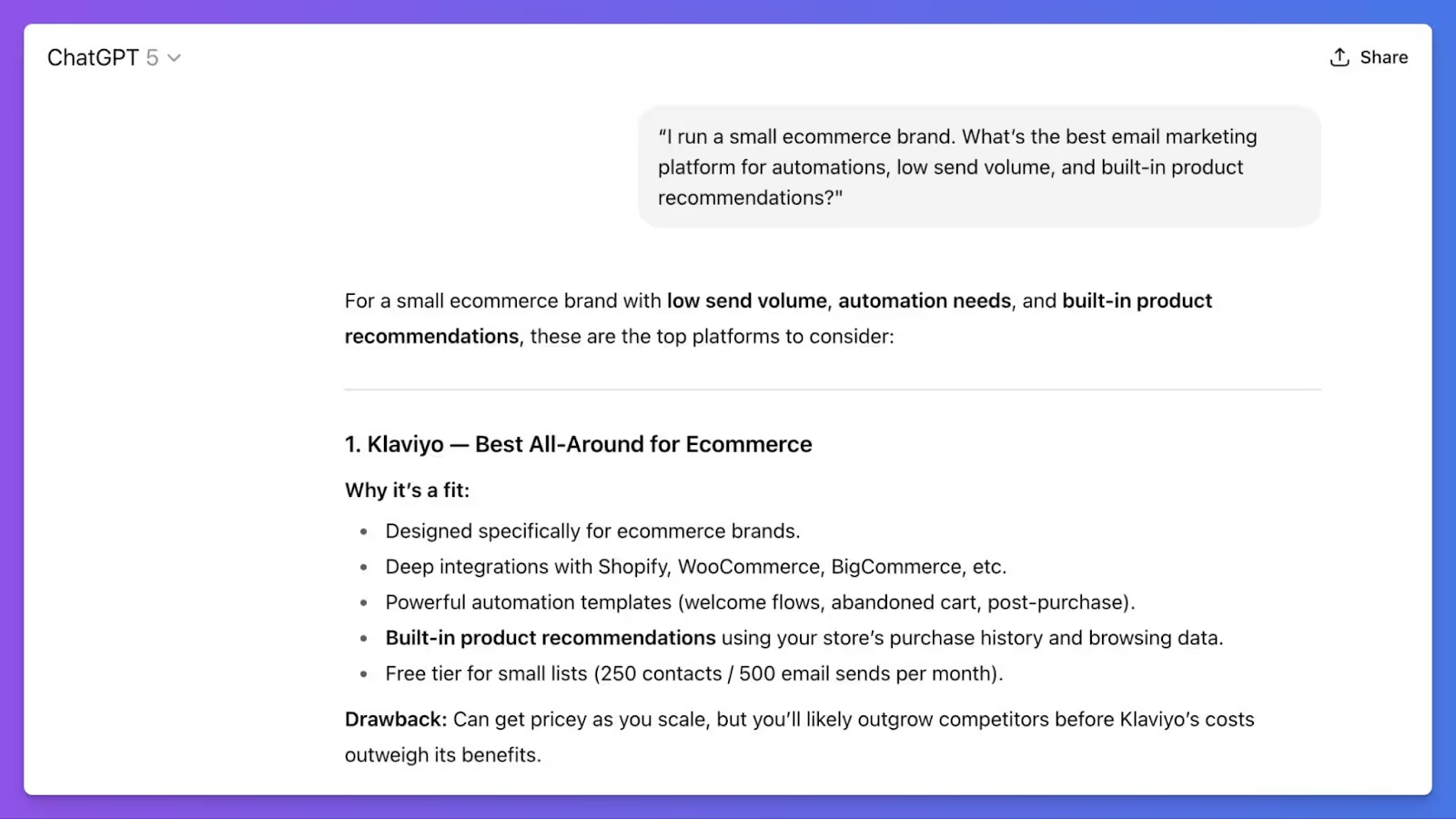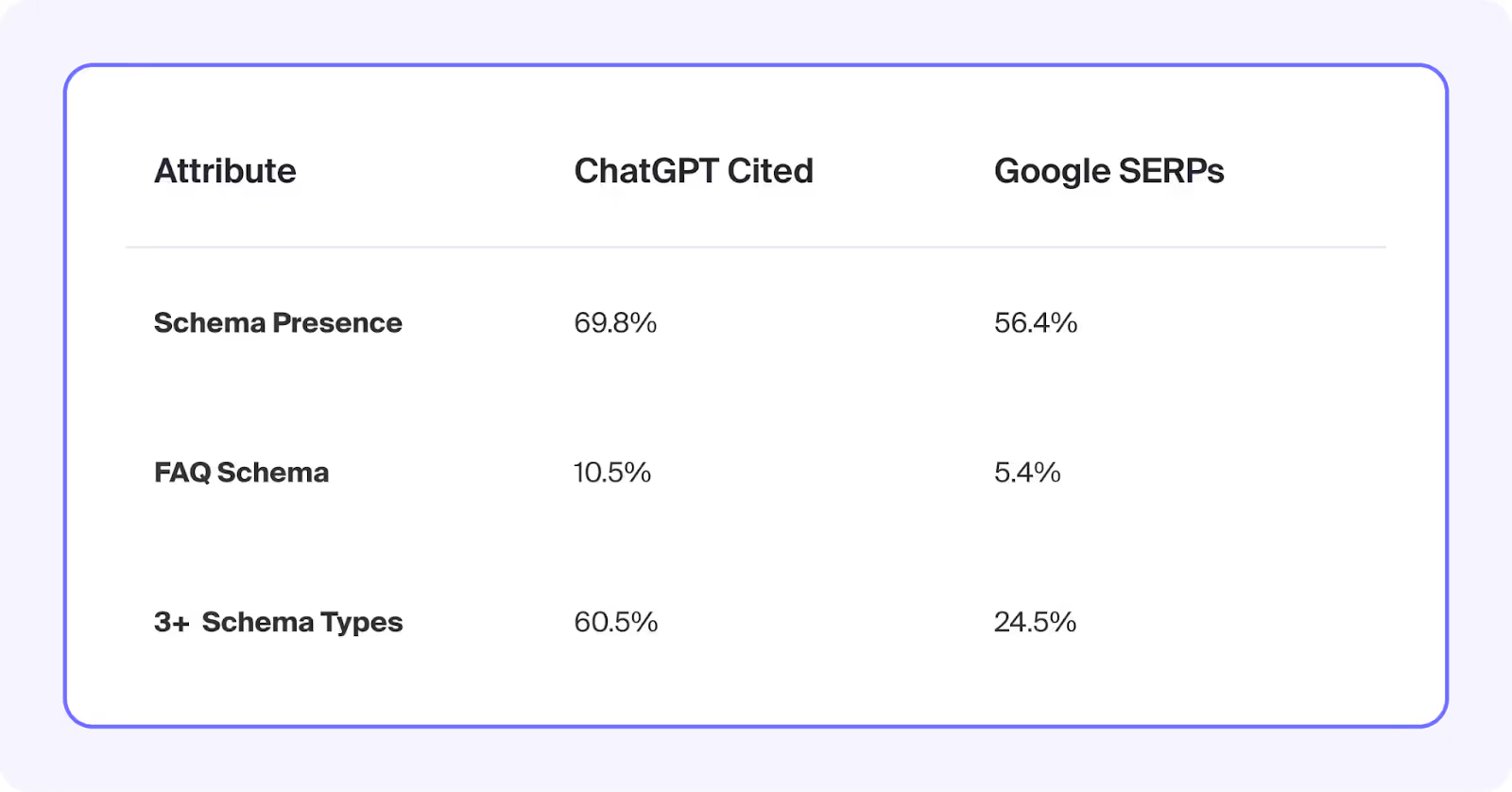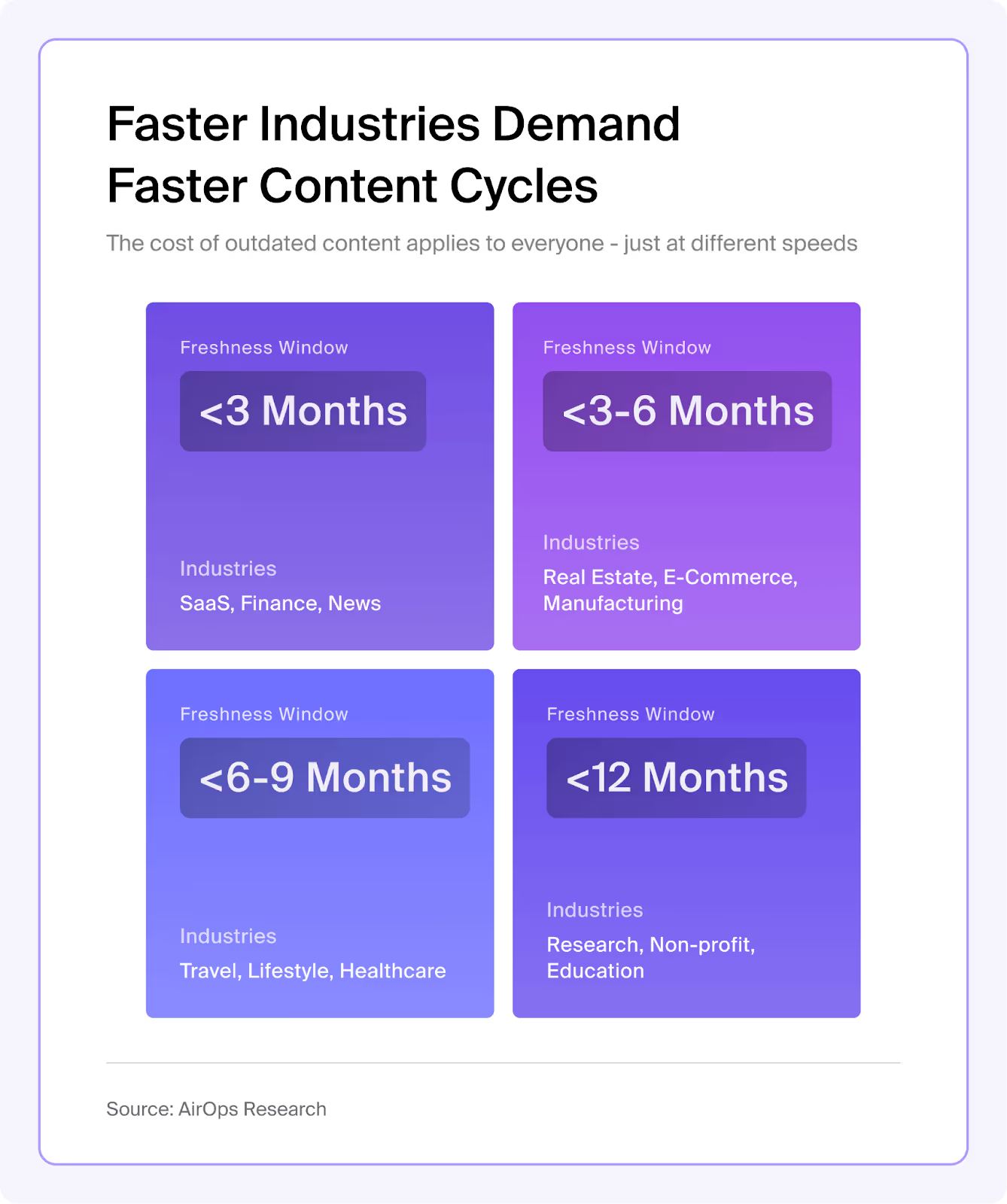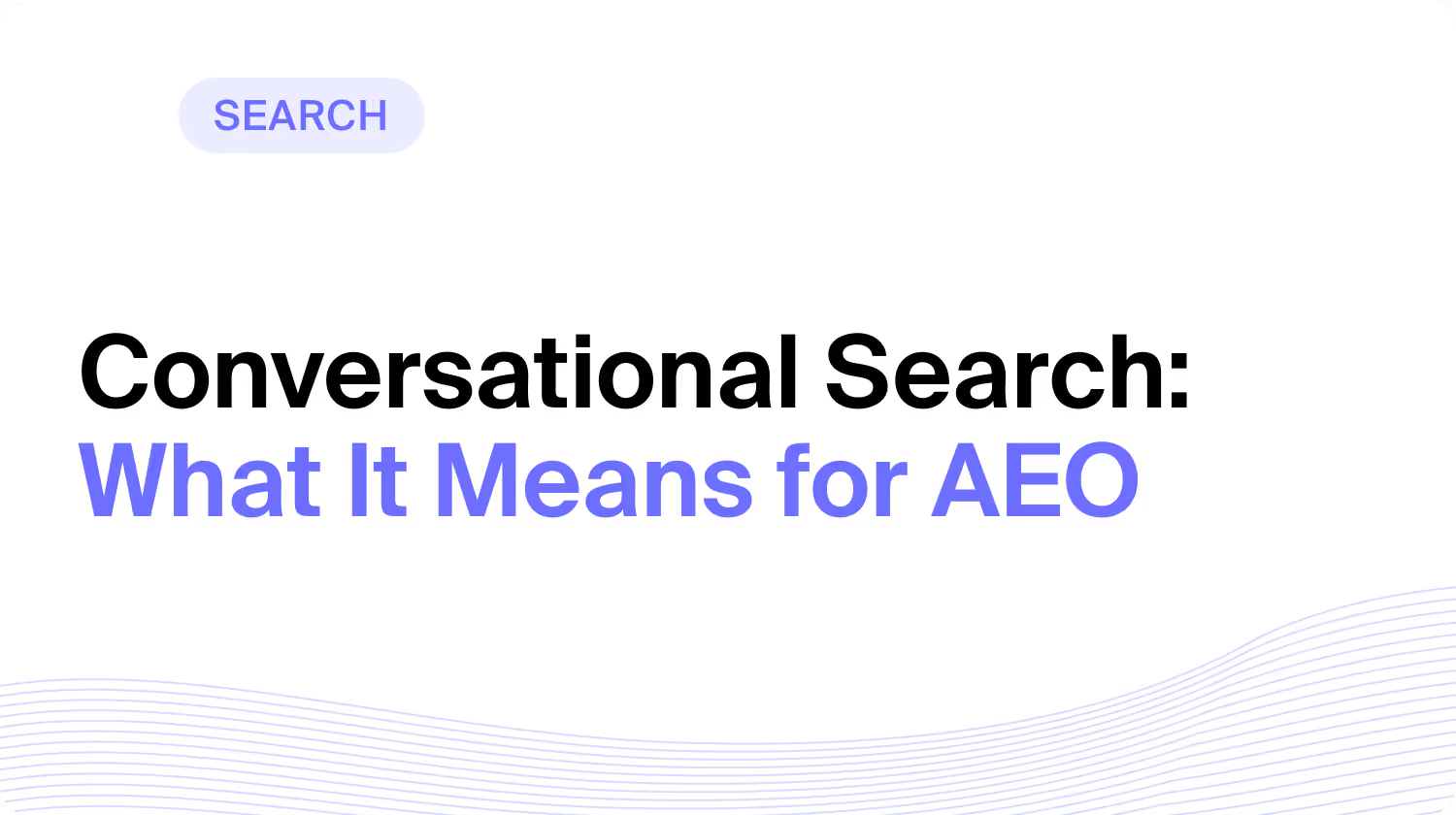AI Search vs SEO: 7 Core Ways It's Different & How It Changes How Customers Find You

- AI answers are replacing clicks: Tools like ChatGPT, Perplexity, Gemini, and Google AI Overviews now satisfy many queries without driving traffic—your brand must be cited in the answer or it vanishes from the customer journey.
- Citations beat rankings: LLMs surface fresh, structured, expert content that leads with the key fact; keywords and backlinks alone no longer guarantee visibility.
- Automate to stay visible: AirOps shows where your brand is (and isn’t) cited, flags the gaps, and triggers updates to keep you showing up while competitors fade.
There’s a big shift marketing leaders, SEOs and content marketers are only now starting to understand about search. The information gathering that used to happen on your website is now happening in AI search conversations.
Here is the key data:
- AI Search Adoption Is Surging: More than 36 million U.S. adults will use generative AI as their primary search tool by 2028—up from 15 million in 2024.
- Gen Z Leads the Shift: Gen Z is 54% more likely than the average consumer to use chatbots like ChatGPT for online information.
- Outdated content is slowly erasing you from AI results
What’s the impact? Discovery no longer occurs on the SERP, but instead its ChatGPT, Gemini, Perplexity, Google AI Overviews, and a growing number of in-app assistants that are the discovery engines.
AI search is replacing SERPs with single answers and cutting brands out of the conversation entirely.
Find more in the AirOps AI Search hub.
How AI Search is Different
AI search is any discovery experience where LLMs decides what to show the user and which sources deserve credit. Instead of listing ten links, the system assembles a single narrative answer, then attaches citations or brief source cards.
The shift is already visible in Google.
A Semrush study of ten million U.S. desktop queries found that AI Overviews appeared in 13% of searches in March 2025, up from 6% just two months earlier.
In plain terms, AI search engines follow a three-step process:
- Understand the query: The model interprets the user’s question using both training data and real-time snapshots of the web. It analyzes intent, phrasing, and context—far beyond traditional keyword matching.
- Generate an answer: Using semantic search, the AI retrieves relevant data, scores its trustworthiness, and blends multiple sources into a single narrative response in natural language.
- Attach citations: If the product supports it (like ChatGPT, Perplexity, or Google AI Overviews), the model cites its sources inline so the user can verify the information.
Visibility is no longer measured in blue-link positions but is earned in the form of inline citations and brand mentions across dozens of AI surfaces that update continuously.
So how exactly does AI search differ from classic SEO? These are the seven shifts that matter most.
SEO vs. AI Search: 7 Core Differences
1. Search Behavior: From Keywords to Full Questions
The biggest shift from traditional SEO to AI search starts with how people ask questions.
Old search behavior revolved around short, specific keywords like:
- “email marketing tool”
- “best CRM for startups”
- “project management pricing”
These were navigational or transactional, and easy to optimize with page-level SEO tactics.
But with AI engines like ChatGPT, Perplexity, and Gemini, search has evolved into something much deeper.
For instance, instead of typing:“email marketing tool, they ask:
“I run a small ecommerce brand. What’s the best email marketing platform for automations, low send volume, and built-in product recommendations?”

These prompts are multi-step, problem-focused, and often personalized. They require understanding context and not just keywords.
What to do:
- Rebuild your keyword strategy around real user questions.
- Use those questions as prompt seeds in ChatGPT to see whether your content is cited or ignored.
2. Query Handling: From One Query to Many Intents (Fan-Out)
In traditional search, a single query led to a single results page.
AI search takes a different approach. It breaks each prompt into multiple sub-questions (a technique called query fan-out), then assembles an answer from multiple sources.
Example:
A user asks:
“What’s the best email marketing tool for small businesses?”
AI search splits this into:
- Best tools for automation workflows
- Platforms with strong segmentation features
- Pricing comparisons for low-volume senders
- Recommendations for ecommerce integrations
It then pulls chunks from different sites to stitch together a complete response.
What to do:
- Create hub-and-spoke content that addresses each micro-intent.
- Instead of one broad “Best Email Marketing Tools” page, publish tightly focused assets like:
- “Best Email Marketing Tools for Ecommerce Automation”
- “Email Marketing Pricing Comparison for Low-Volume Senders”
- “Top Email Platforms for Advanced Segmentation”
- This increases your odds of being cited for each specific need.
3. Optimization Target: From Page-Level to Passage-Level
SEO teams traditionally optimized at the page level: meta titles, headers, keyword density.
AI engines don’t care about the whole page. They scan for small, self-contained passages that answer precise questions.
You could have a 2,000-word blog post reviewing email marketing software, but only one paragraph comparing automation features might be cited by ChatGPT or Google AI Overviews.
What to do:
- Make every paragraph fact-rich, self-contained, and directly answer a likely question.
- Use subheadings, bullet points, and schema to make those answers easy to extract.
- Bonus: This also improves your odds of winning featured snippets.

4. Authority Signals: From Backlinks to Structure & Freshness
Backlinks still matter, but AI engines use a broader trust model. Instead of only counting links, they prioritize:
- Fresh content with recent timestamps
- Clear author attribution and bio links
- Structured data like FAQ or How-To schema
- Consistent claims across all channels
What to do:
- Update content every 4–6 weeks to keep timestamps fresh.
- Add author schema and detailed bios to build credibility.
- Use structured data (FAQ, How-To) to signal clarity.
- Keep facts consistent across your website, blog, social posts, and press releases.

5. Results Format: From 10 Blue Links to 1 Synthesized Answer
Old Google results gave users a buffet of links.
AI search gives them one answer, stitched together from trusted sources. If your content isn’t cited in that answer, your brand doesn’t appear—no matter how well you rank in Google.
What to do:
- Focus on clarity, structure, and extractability.
- Use tools like the AirOps FAQ Schema Generator to create machine-readable sections.
- Lead with the answer, then provide supporting details.
6. User Experience: From Browsing SERPs to Receiving Narratives
AI-generated answers are narrated explanations, not link lists.
What to do:
- Write in a narrative structure: lead with the direct answer, then explain.
- Use bullet points, headings, and schema so your content can be woven easily into AI-generated summaries.
7. Search Platforms: From Blog Posts to Blogs + Social + Community
Google primarily indexed websites.
AI models now pull from:
- Blogs and websites
- Reddit comment threads
- YouTube video transcripts
- LinkedIn posts and bios
Thanks to licensing deals, LLMs have direct access to these platforms. OpenAI reportedly used over one million hours of YouTube video to train GPT-4, and Reddit’s data licensing now accounts for roughly 10% of its revenue.
What to do:
- Go beyond your blog.
- Post clear, valuable responses on Reddit.
- Script YouTube videos so they are easy to transcribe and extract.
- Add author information to LinkedIn profiles and posts.
- Treat every platform as a potential AI discovery surface.
The Actions That Matter for AI Search
Traditional SEO rewarded checklists: links, keywords, meta descriptions, and click-through data.
AI search runs on something different: freshness, structure, and credibility, updated continuously, not quarterly.
Here is what has changed and what to do about it.
1. Create Trust with Structured Data & Expertise
Classic SEO rewarded backlinks and domain authority. Large language models do not “crawl and rank” in the traditional sense. They generate answers based on recency, clarity, and extractability.
Models favor content that is:
- Recently updated
- Written by a clearly identified expert
- Structured with schema like FAQ or How-To
- Consistent across all channels
Schema helps models match queries with exact passages. Structured pages are 2–3x more likely to earn citations. Pages with rich schema are 13% more likely to earn AI citations, and pages with clean, sequential headings are nearly three times more likely to be cited.
What to do:
- Add author bios and clear attribution
- Use structured data on every applicable page
- Keep timestamps fresh
- Make your expertise machine-readable
2. Lead with Your Answer
LLMs lift direct, concise statements. Don’t bury your insight. Evidence placed early in content improves trust signals and extractability.
What to do:
- Open with the direct answer, stat, or takeaway
- Keep it concise, then expand with supporting details
- Review high-value pages to ensure key facts are positioned up front
3. Keep Your Content Fresh with Regular Updates
Most SEO programs still operate on a monthly or quarterly update cycle.
AI search engines move faster.
- Models like ChatGPT, Claude, and Gemini retrain continuously on live web snapshots
- Google AI Overviews refresh content in near real time
- From January to March 2025, Google queries showing an AI Overview doubled
Content that is even slightly out of date can vanish from AI results. Pages updated every 4–6 weeks are far more likely to be cited. Even minor edits and a fresh timestamp help models prioritize your content.

What to do:
- Shift to light, frequent updates
- Even a minor revision plus a fresh timestamp can keep your content in a model’s active memory
- Refresh your content every 90 days like Shopify and other top-tier brands
4. Add Primary Evidence
First-party data, proprietary visuals, and original research differentiate your content from commodity sources and strengthen authority in model scoring.
AI search engines favor content that is factually accurate, up to date, well-structured, and authoritative. Proprietary data and visuals check all those boxes.
What to do:
- Include proprietary charts, survey results, or original photos
- Use HTML tables instead of images for better extraction
- Add alt text and captions to all visuals
- Highlight original data in bullet points or block quotes
- Pair data with structured schema, author credentials, and visible timestamps
5. Create Content With Specificity
Covering narrowly defined questions in depth helps models match your content to specific user intents without introducing irrelevant details.
What to do:
- Target tightly scoped topics instead of trying to cover everything in one post
- Organize content so each page cleanly maps to a distinct intent
- Remove unrelated sections that dilute topical focus
6. Be Consistent in Your Message Across Channels
Mismatched facts across platforms kill trust. Contradictory claims, numbers, or dates weaken trust signals and can push models toward other sources. AI looks for alignment.
What to do:
- Align terminology across your website, blog, social posts, press releases, and partner content
- Audit regularly to catch inconsistencies
- Maintain a central reference for approved stats and messaging
7. Optimize with Continuous AI Workflow Loops
Traditional SEO is checklist-driven:
- Fix meta tags
- Rework headers
- Refresh old blogs
What to do:
AI search needs a continuous loop:
- Track where your brand is cited or not across ChatGPT, Gemini, Perplexity, and Google AI Overviews
- Identify gaps such as outdated timestamps, missing schema, or no author attribution
- Update or create content to close those gaps
- Re-prompt models and test if visibility improves
Repeat this cycle until your content earns consistent citations, then start again. This is less like traditional SEO and more like product development:
- Regular updates keep you relevant
- Structured feedback identifies where you are missing
- Ongoing investment ensures you stay visible wherever AI engines look for answers

Search Is Still Here, Just In a New Form
Search behavior is changing, but the demand for answers is not.
As Wil Reynolds of Seer Interactive explained in a recent AirOps webinar:
“People still have these questions. Just because you’re not getting the same amount of traffic doesn’t mean that people have dropped in their number of questions. They’re just asking them in new places.”
Win AI Search with AirOps
AirOps is the only all-in-one platform that shows you exactly where your brand appears (or doesn’t) across ChatGPT, Perplexity, Google AI, and more—then tells you what to fix, which queries to target, and gives you the tools to take action immediately by updating content, earning citations, and joining high-visibility conversations.
Book a live AirOps demo to make content ops your unfair advantage to win the AI answer box before your competitors even notice it’s gone.
Win AI Search.
Increase brand visibility across AI search and Google with the only platform taking you from insights to action.
Get the latest on AI content & marketing
Get the latest in growth and AI workflows delivered to your inbox each week



.avif)
